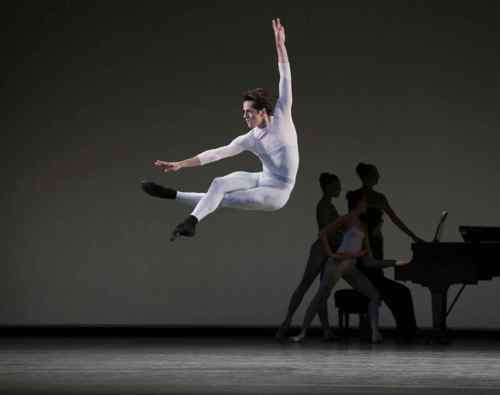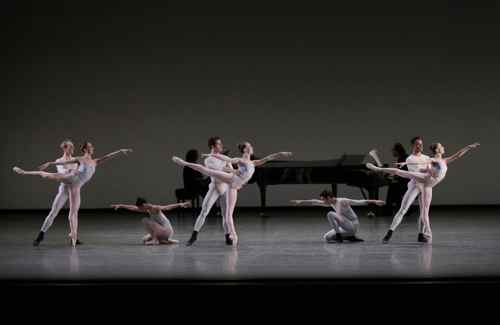In Creases does well enough as a title for Justin Peck’s latest work for the New York City Ballet because you understand the reference to arithmetic in the punning title. And Peck—on whom the company may be pinning its choreographic hopes—keeps to his subject matter doggedly by manipulating his eight dancers. Grouping and regrouping, they make you pay keen attention to the shifting clusters’ numbers. Still the ballet’s title doesn’t arouse much excitement or joy; neither—alas—does the choreography.
 Robert Fairchild in Justin Peck’s In Creases for the New York City Ballet
Robert Fairchild in Justin Peck’s In Creases for the New York City Ballet
Photo: Paul Kolnik
The two gleaming ebony pianos on which Philip Glass’s score is played onstage by Elaine Chelton and Alan Moverman provide as much design as is necessary. The costumes were “conceived,” the house program stated, by the choreographer and Marc Happel. Essentially woozy-gray unitards, they can’t help looking like union suits and while the women—all those beautiful feet!—were allowed the customary pink satin pointe shoes, the men look misguided right through the toes in black ballet slippers with socks to match.
The score, being by Glass, is expectedly spare, but along comes a pretty sequence of notes that repeats over and over, with two women dancing to it in unison, each partnered by a gentleman friend. This passage was old-timey and, given the general mechanized effect, welcome. Still it hardly influenced the tone of the piece as a whole, which we encounter so often nowadays: frosty abstraction that offers little of interest to see and nothing to ignite the imagination.
 The full cast of Peck’s In Creases
The full cast of Peck’s In Creases
Photo: Paul Kolnik
Yes, the number of dancers in action at any given moment seems to matter terribly, but Peck never lets the baffled viewer know how or why, so the ballet appears pointless—or at least inconclusive. Peck is unquestionably intelligent and capable of invention and subtlety—we’ve seen that in his earlier work—but the spotlight currently shining on him in the dance world is perhaps too bright to allow him to develop his talents at a reasonable pace. In Creases is unexpectedly—and cleverly—short; nevertheless its brevity undermines its claim to importance. It looks as if its choreographer ran out of ideas and decided to quit. Besides, dance is not made of ideas but rather of people moving to music in ways that move their audience.
In Creases had its premiere back in July at the Saratoga Performing Arts Center, the company’s long-time summer home.
© 2013 Tobi Tobias




“frosty abstraction that offers very little to see…” does seem to be the order of the day for a lot of choreographers and not just by the young ‘uns. It doesn’t grab me, either, TT, but it just might reflect the “frosty distraction” that seems to be the hallmark of a generation that texts each other at parties, rather than walking across the room and having a conversation, or engages in the same activity while they’re allegedly watching a performance.
I so agree with you, Tobi: “… dance is not made of ideas but rather of people moving to music in ways that move their audience.”
I saw this performance and enjoyed it. I have seen three of Justin Peck’s works and noticed that he performed as well in other works on the same programs. He seems to enjoy performing with the corps. I think that his choreography is heavily influenced by making the corps a strong part of each of his pieces.
Your reaction to “In Creases” matches mine for “Fearful Symmetries,” which I saw for the first time this weekend.
Always enjoy your comments.